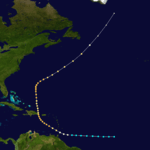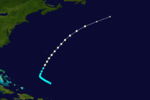1921 Atlantic hurricane season
| |
| Season summary map |
| First system formed |
June 1, 1921 |
| Last system dissipated |
November 25, 1921 |
| Strongest storm1 |
Six – 941 mbar (hPa) (27.79 inHg), 140 mph (220 km/h) |
| Total storms |
7 |
| Hurricanes |
5 |
| Major hurricanes (Cat. 3+) |
2 |
| Total fatalities |
6 |
| Total damage |
$3 million (1921 USD) |
| 1Strongest storm is determined by lowest pressure |
Atlantic hurricane seasons
1919, 1920, 1921, 1922, 1923 |
The 1921 Atlantic hurricane season ran through the summer and the first half of fall in 1921. The season was near average, with six tropical cyclones forming during the season.
Timeline
Storms
Hurricane One
| Category 1 hurricane (SSHWS) |
|
|
| Duration |
June 16 – June 26 |
| Peak intensity |
90 mph (150 km/h) (1-min) 980 mbar (hPa) |
A tropical storm formed in the western Caribbean before moving across the Yucatan peninsula into the southern Gulf of Mexico. The storm recurved towards the north, strengthening into a category 1 hurricane before it struck Sargent, Texas. During the night of June 21, winds increased to 68 miles per hour (109 km/h) at Corpus Christi, Texas. A barge with 18,000 gallons of oil sank in Port Aransas, Texas. A storm surge of 7.1 feet (2.2 m) was measured at Pass Cavallo. As the cyclone moved inland, it passed directly over Palacios, Texas, Wharton, Texas, and Wallis, Texas. Winds gusted to 60 miles per hour (97 km/h) at both Galveston, Texas and Houston, Texas. Heavy rains accompanied the system, with 10.10 inches (257 mm) recorded at Matagorda, Texas.[1]
Hurricane Two
| Category 1 hurricane (SSHWS) |
|
|
| Duration |
September 4 – September 8 |
| Peak intensity |
80 mph (130 km/h) (1-min) <985 mbar (hPa) |
A category 1 struck Tampico, Mexico in early September after moving northwest from the Gulf of Mexico. After it dissipated on September 8, an extremely heavy rainfall event ensued across central Texas, which continued into September 11. In Williamson County, Texas, a new 18-hour rainfall record was set for the United States as 36.40 inches (925 mm) was recorded at Thrall;[2] the storm total rainfall there was 39.71 inches (1,009 mm).[3] The deluge led to one of the most destructive floods in the history of San Antonio, Texas. Water rose to 7 feet (2.1 m) deep in the city, forcing people to evacuate vertically within taller buildings. The most significant river floods occurred on the Little and San Gabriel rivers, where 159 people perished. Combined with the death toll from elsewhere across the region, 215 people died due to this storm and damages were estimated at $19 million (1921 USD).[1]
Hurricane Three
| Category 3 hurricane (SSHWS) |
|
|
| Duration |
September 6 – September 17 |
| Peak intensity |
125 mph (205 km/h) (1-min) 961 mbar (hPa) |
A Cape Verde-type hurricane, Three formed about 500 miles east of the island of Trinidad, and organized into a tropical storm soon after forming. It moved westward and struck the Windward Islands as a Category 1 hurricane. It then made an eventual curve in the eastern Caribbean Sea and grazed the Dominican town of Palo Bonito as a Category 3 hurricane, and almost immediately after landfall was downgraded into a Category 2 hurricane. It tracked northward as a Category 2 hurricane and after a short lull was upgraded back to a Category 3 hurricane and kept moving to the north. At approximately the same latitude as the Georgia - Florida border, the system shifted to the west-northwest and struck the island of Bermuda as a Category 2 hurricane before curving toward the northeast. It became an extratropical cyclone well off the coast of Newfoundland and accelerated before dissipating about 100 miles off the southern tip of Greenland .
Hurricane Four
| Category 1 hurricane (SSHWS) |
|
|
| Duration |
September 8 – September 14 |
| Peak intensity |
90 mph (150 km/h) (1-min) 979 mbar (hPa) |
A category 1 formed in the Atlantic and never approached land. It dissipated on September 14.
Tropical Storm Five
| Tropical storm (SSHWS) |
|
|
| Duration |
October 15 – October 17 |
| Peak intensity |
70 mph (110 km/h) (1-min) <998 mbar (hPa) |
Another notable system was a tropical storm that made a transatlantic journey from off the coast of South Carolina to just southwest of the Azores. It was later determined that it was extratropical for most of the journey.
Hurricane Six
| Category 4 hurricane (SSHWS) |
|
|
| Duration |
October 20 – October 29 |
| Peak intensity |
140 mph (220 km/h) (1-min) 941 mbar (hPa) |
The most notable storm of the season was the Tampa Bay hurricane of 1921. It developed in the southwestern Caribbean Sea on October 20. It tracked north-northwestward, steadily strengthening into a hurricane on October 22. The storm turned more north-northeastward, and upon reaching the Gulf of Mexico on October 24 it rapidly intensified to a 140 mph Category 4. It weakened as it continued to the northeast, making landfall north of Clearwater on October 25 as a Category 3 hurricane. It crossed Florida, turned eastward across the Atlantic, and became extratropical on October 28 southwest of Bermuda. Its small and quick nature, as well as well-executed warnings, only caused $3 million in damage (1921 USD), with 6 casualties.
Tropical Storm Seven
| Tropical storm (SSHWS) |
|
|
| Duration |
November 19 – November 25 |
| Peak intensity |
60 mph (95 km/h) (1-min) <1003 mbar (hPa) |
Tropical Storm Seven formed on November 19. It made landfall in Cuba before dissipating on November 25.
See also
References
External links









